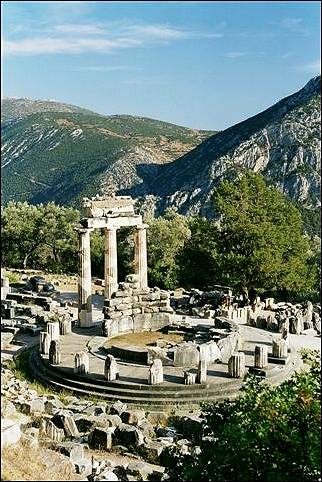
|
Varied Epiros
Nature and culture
in Central Greece
Epiros is a region in central and west Greece. On the north it is bordered by Albania and Macedonia. It is one of the most beautiful and sparsely populated areas in Greece, with high mountains, deep valleys and - in Spring - wild rivers, spanned by beautiful old bridges. Wolves, bears, lynx and wild boars are even assumed to live in the nature reserves. Except for the highlights of Delphi and the Meteora monasteries, the region is not visited by many foreign tourists. The Greeks themselves, though, love to spend their vacations here.
Travelogue & photos: Marianne Bekkering
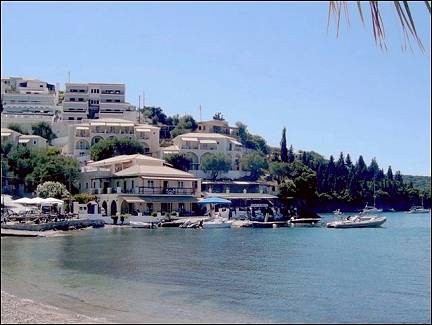
|
We drive our rental car to Sivota and have a late lunch at its lively harbor: tzaziki with tomato salad and then grilled sardines; and of course a carafe of local wine.
Our hotel sits on a hill and from our terrace we have a view of the bay, where sailing boats are returning for the night.
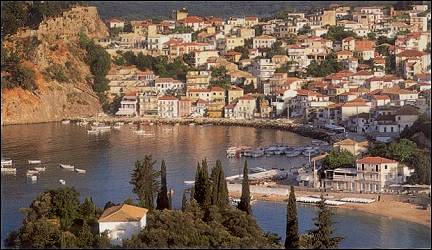
|
The next day we drive to Parga, one of the best-known towns on the shore. It is picturesque, being built on a mountain slope. But we think it's very touristy and are glad we booked a hotel in the quiet and less touristy Sivota.
The road between Sivota and Parga winds along next to mountains and gorgeous olive groves. On the other side is the sea with bays and here and there mini beaches, always with crystal-clear water.
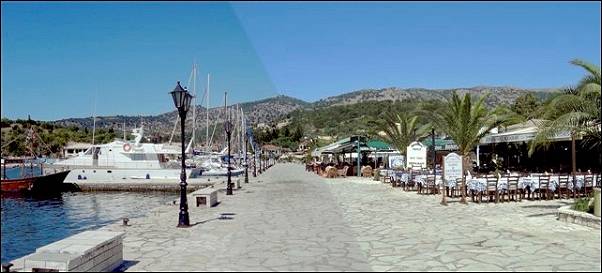
Necromanteion and the Acheron river
Descending into the underworld via steep stairs
The weather is wonderful again today as we drive to Mesopotamo, a little south of Parga. We visit Necromanteion, the oracle of the dead, which in ancient times was believed to be the entrance to the underworld (Hades) and where you could get in contact with the deceased. At Necromanteion the Acheron river, which the dead must cross to get to the underworld, goes underground.
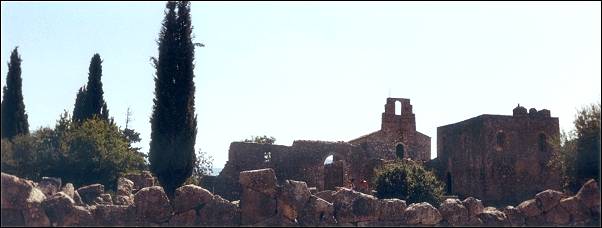
The buildings that housed the oracle date from the 3rd century BC, but only their foundations remain. In the 18th century, a monastery was built here, of which the chapel remains.
Before approaching the oracle, visitors had to perform complicated rituals. First, they would walk through a dark corridor with rooms on both sides. In the first two rooms, pilgrims would eat pork, broad beans and shell fish and drink milk with honey.
After that they would bathe to cleanse themselves after which they would throw a stone against a narrow door post to keep themselves from dying. After sacrificing a ram, they would enter a long, maze-like corridor with iron doors which were supposed to be gates to the underworld.
By then, they would be rather confused; it is said that the ritual meals probably contained drugs.
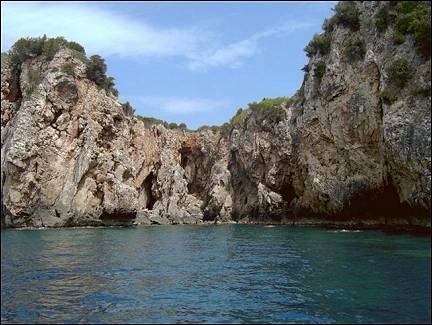
|
At the end of the maze they would enter the oracle hall, where the spirits of the deceased appeared to them. On both sides of the oracle hall sat enormous vases for offerings the visitors were supposed to give.
After receiving answers to their question, the pilgrims would proceed via a back corridor to a seperate room, where they had to stay for three days to cleanse themselves (or wait for the effects of the drugs to subside?).
We explore everything extensively, including the descent into the underworld via steep stairs.
Meanwhile, it's become really hot outside, so we drive to the sea for a drink.
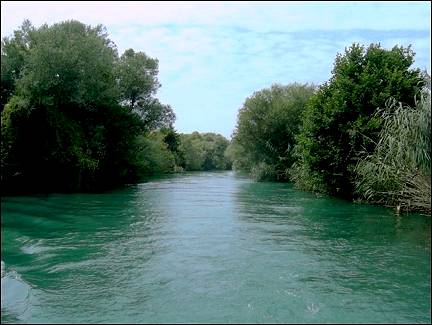
|
In Amoudia we see the Acheron river estuary. As we stand there looking, a kid approaches us and offers us a boat ride. Boat rides are nice when it's hot, so we accept his offer.
First we sail to the Blue Cave, a small cove with a cave just off the coast, and then we sail upstream on the Acheron, which gets narrower as we proceed.
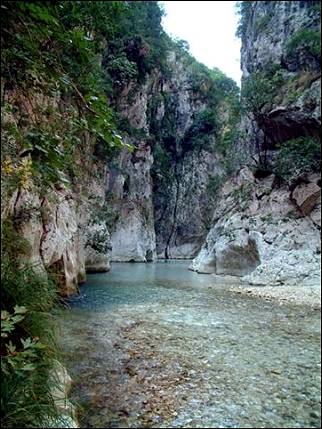
|
We have lunch in Amoudia: delicious small fried fish, a little bigger than sardines. We continue upstream to Gliki, to the source of the Acheron. The water is clear and flows fast; it's ice cold. There is a foot path along the river, which we follow to find its source.
We take a detour through the pretty interior on our way back to Sivota. A thunderstorm is expected in the late afternoon and we see big, dark-grey clouds gathering over the mountains. It looks wonderful. Here near the coast it hardly rains, but we see veils of rain in the mountains.
We're not hungry, so we just have a cocktail on the promenade, with a view of people passing by and boats floating in the port.
Dodoni, Agios Georgios and Arta
A Greek theatre and Roman aquaducts
The next day we drive via the port town of Igoumenitsa to Dodoni and then, via the Roman aquaducts near Agios Georgios, to Arta.
Dodoni has the oldest Zeus oracle in Greece: it dates from 1000 BC. During the Neolithic period this sanctuary was devoted to the earth goddess Gaia. Between 1900 and 1400 BC it became an oracle of the Greek supreme deity Zeus.

In the rustling of the leaves of the oak that stood here and the sound of bronze kettles around it, priests heard the words of the gods. They conveyed them in "oracle language" (read: multi-interpretable nonsense) to those who came for council. People came from far away to consult the oracle.
The sanctuary existed until 400. The tree was felled in 393 on orders from the (Christian) Roman emperor, who wanted to eradicate pagan practices.
In 167 BC the Romans also destroyed it and rebuilt it as an arena for bull and lion fights. There are the remains of an amphitheatre which seated 18,000 people, built in the third century BC.
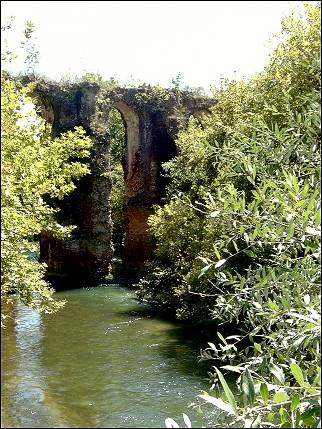
|
Dodona also has the remains of a stadium, a theatre, a city hall, a magisterial building and three temples. It's pretty impressive and on top of that located in gorgeous surroundings with mountains and a pretty valley.
When we leave Dodoni, we want to have lunch by the Lake of Ioannina, but there is nothing there and Ioannina itself is a big and crowded city.
So we drive to the Roman aquaducts near Agios Georgios, farther south, in the direction of Arta.
The drive takes us through a gorgeous mountainscape. The aquaducts are beautiful and stand in a wild flowing river. After admiring them, we continue on to Arta to see the seventeenth century bridge at the western entrance to the city.
We have lunch in an outdoor café next to the bridge. There is a gruesome legend about the bridge: durign its construction, everything that was built during the day, collapsed at night. The construction workers were desperate. One day, the master builder heard a bird singing in the ruins: "Take your wife to construct the bridge and sacrifice her quickly."
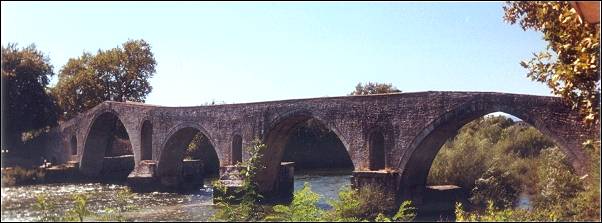
The master builder was heartbroken, but he did as he was told. He had his beloved walled in alive in a pile and then they were able to finish the bridge. Is this true? It is said that 60 years ago, a human skeleton was discovered in a space in the bridge.
Megalo Papingo
Landmarked thirteenth century village in Zagoria
Another beautiful day. We leave Sivota for the interior. Before we say goodbye, we stop at the lookout point for a final view of Sivota.
We drive to Megalo Papingo in the Zagoria section of Epiros, in the mountains. We approach the mountains by way of Igoumenitsa, in the general direction of Ioannina and then farther north.
The landscape is impressive and very green. High mountains, pretty valleys, countless hairpin turns and cute villages. The farther away from the coast we get, the less readable names of towns become, because they are often only written in Greek. It's a good thing we have a map which has both Greek and English names.
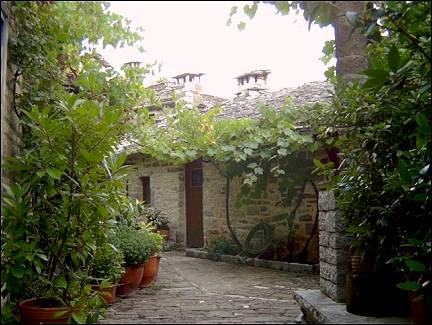
|
Megalo Papingo is an authentic, landmarked Zagorian village, dating from the 13th century. Narrow streets with typical Zagorian houses, built with slate and with stacked-slate roofs. A huge rock, part of the Timfi mountains, hovers over the village.
In the past, this was a village of shepherds. Nowadays only 125 original inhabitants remain, the others have moved to the cities to find jobs.
On a backstreet we find an authentic hotel with a garden. It is owned by a nice couple, originally from Athens, who bought several houses here. They live here and rent out some of their rooms to tourists.
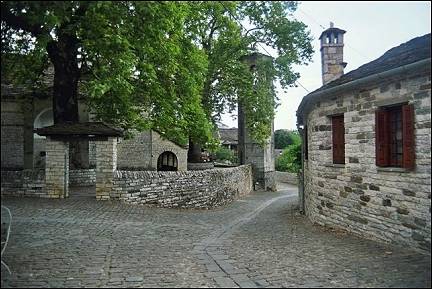
|
In the evening we have dinner on a terrace with a view of the old village. We have spinach pie with tzatziki, sausages and pork chops, surrounded by six cats. A good bottle of wine to go with the food and another day ends well.
Tour of Zagoria
Green mountains, cool rivers and the huge Vikos canyon
Today we are exploring the vicinity of Megalo Papingo. Wild, high mountains, a lot of greenery and pretty villages.
We descend into the valley and then climb to Aristi. We continue on to Konitsa in the north, where we take a secondary road.
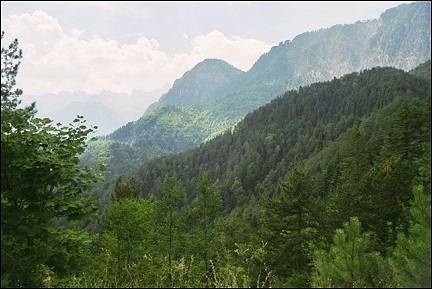
|
We try to take an unpaved road near Palioseli to Vrisochori, but the road turns out to be too steep to risk our rental car.
Instead we drive back to Aristi on the same road; we don't mind, because everything looks different going the other way and just as beautiful. We have lunch in Aristi with a great view of the valley and a road with many hairpin turns, which leads to Megalo Papingo. After lunch, we drive to Monodendri and Oxia to see the Vikos canyon.
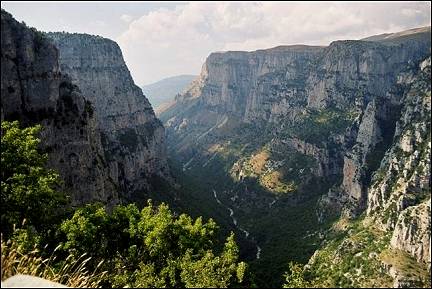
|
From Monodendri an unpaved road leads to Oxia, which has a lookout point. The Vikos canyon is about 900 meters deep and approximately the same width. It's the deepest canyon in the world and from Oxia the view is great.
A narrow path with no handrails leads along the edge of a deep chasm. It's not a path for people with fear of heights. It's very quiet here, except for the rustling of leaves, bird songs and the tinkling of bells that the sheep have around their necks. We are the only visitors, which makes it even more special.
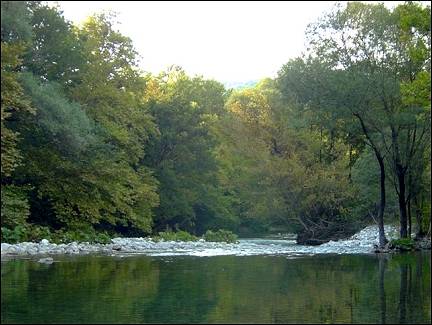
|
On the way back we visit Monodendri and Vitsa. Both are mountain villages in which some of the houses are over-restored and others are newly built in the old style; by the looks of it, it's all for tourists.
On the way to our hotel, we cool our feet in an ice-cold river between Aristi and Megalo Papingo.
Back at the hotel we take a shower and then go into the village for dinner. We find a nice terrace where they serve the best lamb chops we've ever had with a great gratin dauphinois.
Kipi, Kalambaka and Meteora
Old bridges, narrow mountain roads and fantastic rock formations
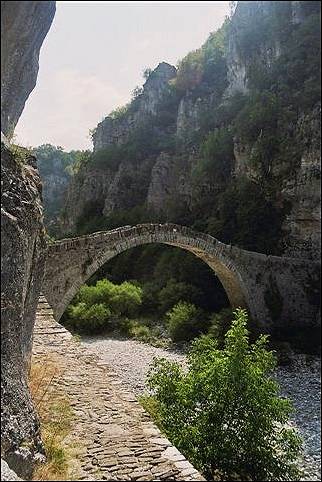
|
Next morning we drive to Kipi, which has two nice old bridges. One single-arched, the other with three arches, the Plakídas bridge.
In the past, a bell used to hang underneath this type of bridge: if it rang, it meant that there was too much wind, so one shouldn't cross.
There isn't a bell anymore and both bridges are no longer in use, but they give a good impression of what it must have been like in the past.
We drive to the north of Ioannina and the big lake next to it and then on to Kalambaka.
The landscape on the way is very beautiful, but unfortunately the road between Ioannina and Metsovo is clogged with trucks. It's also rather hazy because of the heat, so it's hard to enjoy the view.
Even though this is a highway, it only has two narrow lanes, which sometimes merge in turns. Every now and then, a goat herd suddenly appears.
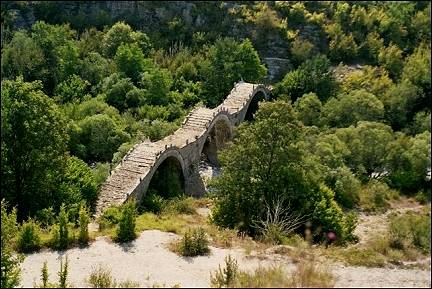
|
We stop for a moment in Metsovo, which is a ski resort during the winter season, but it turns out to be a kitschy, overcrowded village, so we continue on our tour.
The road becomes more quiet now. We're at a high altitude, where we see a lot of snowplough stations, so apparently in the winter it snows a lot here. But now there are mainly many large sheep herds with their shepherds.
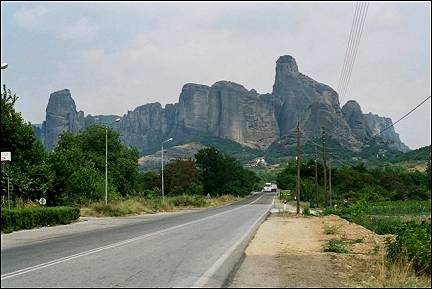
|
10 km from Meteora, we can already see the bizarre rock formations.
We find a hotel with a view of those rock formations.
In the evening we have dinner on the large square, which has a waterfall fountain.
The monasteries of Meteora
The tourist buses only stop at the large monasteries
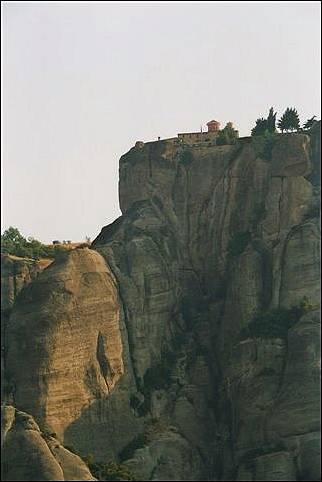
|
Today we visit the monasteries on top of those curious, narrow, sandstone rocks. The unusual rock formations are already extraordinary by themselves, but the monasteries make the surroundings even more special.
There are two theories about how these stone masses were formed. One suggests that the wind wore them away through the ages and the other that there used to be a lake and the water eroded the rocks.
In the 12th century the small monasteries were built on top of the rocks; starting from the 14th century, the larger ones were built. Before the monasteries were there, the monks lived in caves below the rocks.
There are also two theories about how the monks reached the top: according to one the first ones climbed up with a kind of pickaxe, after which winches were used to haul up the building materials as well as the other people; according to the other theory, kites with rope ladders attached to them were flown.
Nowadays there are stairs, hewn out of the rock. For most of the monasteries, it's quite a climb, but both the monasteries and the wonderful views are worth it.
Some of the monasteries have beautifully preserved and restored frescoes in their chapels, others are in an advanced stage of deterioration. But it's all wonderful to see.
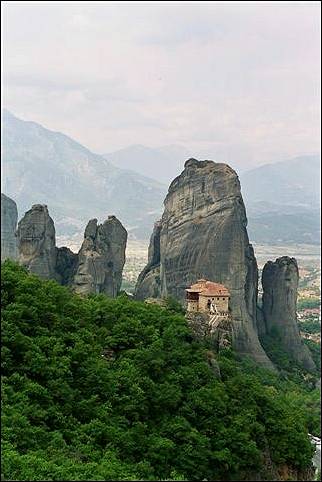
|
We tend to prefer the smaller monasteries, like Agias Nikolaos Anapausa, even though they require more climbing to reach. They are more intimate and less touristic. The large ones are more crowded, because there the tour buses stop. It works like natural selection: climbing means relative quiet - hardly any effort at all to get there, means super-touristy.
After the Agia Roussanou monastery, we visit a lookout point where we have a great view of the other monasteries and the rock formations.
We return to Kalambaka and have a sumptuous lunch at Restaurant Meteora, a real Greek tavern, which doesn't have a menu, but where you are invited to take a look in the kitchen and point out what you want to eat. We have a view of the large waterfall fountain on the big square.
Delphi
Temples, sacrificial houses, a theatre and a huge stadium
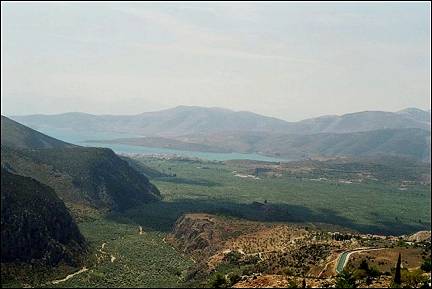
|
Today we drive to Delphi. The first part after Kalambaka is flat and rather dull. At Amfissa the landscape becomes mountainous and pretty. Unfortunately it's still hazy.
In Delphi we find a hotel where we have a great view from our balcony of the valley with olive groves and the sea behind them.
Already in the eighth century BC Delphi was the largest religious and spiritual center of ancient Greece, famous all over the Mediterranean region. This lasted until it became a Roman province in 160 BC, when its decline began, until it became a diocese in 380.
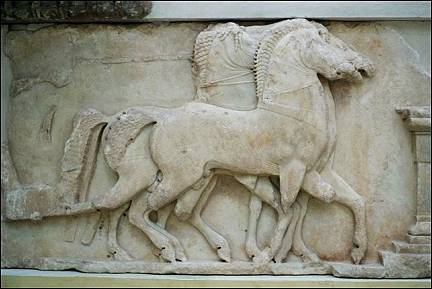
|
The ancient sacred city with its sanctuary and oracle of Apollo (the god of music and prophecy) is located directly next to modern Delphi. It feels as if we have travelled back in time when we wander through the sacred city with its temples, sacrificial houses, theatre and huge stadium.
Before we explore the ancient city, we visit the museum, which exhibits many of the archeological finds from the site. It also has a scale model of what the city must have looked like in antiquity. That helps a lot when vsiting the site. The museum has beautiful sculptures, wall decorations and jewelry, and other other delicately tooled objects.
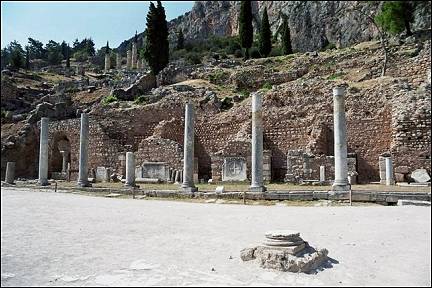
|
Delphi is the sanctuary of Apollo, who descended from Mount Olympus to pick a site for his oracle. When he found the place, he went on retreat with the Muses, to celebrate the secret rituals of poetry, music and dance.
Government delegations came here to seek council about important affairs of state, like war and peace. They donated valuable gifts and statues and built the first temples here.
But ordinary people also came here for advice. After paying and sacrificing an animal on the altar, the question was taken to the priestess or pythia, who would answer it in trance. The trance was possibly induced by the fumes that rose from a crack in the earth, over which the pythia sat on a tripod. Her answers were interpreted by a priest.
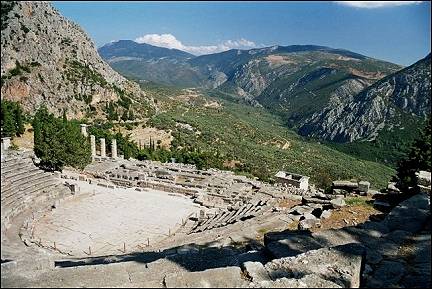
|
The site of Delphi was considered the "navel of the world"; this was determined when Zeus (the supreme deity who reigned from Mt. Olympus) let two eagles fly from the two ends of the world. Their flight paths crossed above Delphi and thus it was established that the center of the world was there.
Back to Preveza
Sea, islands off the coast and beautiful clear bays
We get up early and drive to Preveza, 280 km from Delphi. On our right are mountains with valleys between them, filled with olive or citrus groves. To our left is the sea and behind it the mainland of the Peloponnesus; later we also see the bridge to the Peloponnesus.
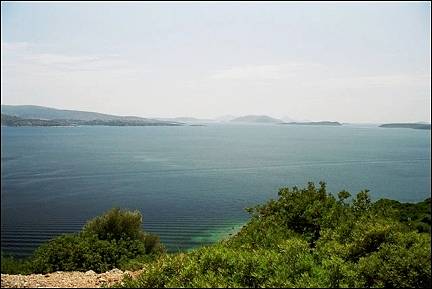
|
We stop in the fishing town of Mesolongi, hemmed in between two salt lakes, for a drink. When we continue our drive, between Astrakes and Paleros we have views of the sea, the islands off the coast and beautiful clear bays.
We have lunch in Paleros: small fried fish and grilled sardines. A few scrawny cats gather around us and we give them the heads and bones, so they have a good day, too.
Then we drive via Vonitsa to the island of Lefkada/Lefkas, which we visited once before on a bicycle vacation. We find a hotel by the sea, on the east side of the island; our terrace has a view of the mainland.
On our last day we are lazy. We read on the miniature gravel beach, swim a little and then have a late, excellent farewell lunch in the fisherman's harbor on the way to Lefkada City: fried red snapper with a bottle of good wine. One more night and our vacation is over. Too bad.